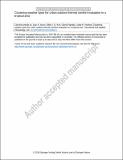| dc.contributor.author | Acero, Juan A. | |
| dc.contributor.author | Koh, Elliot J. K. | |
| dc.contributor.author | Pignatta, Gloria | |
| dc.contributor.author | Norford, Leslie Keith | |
| dc.date.accessioned | 2020-11-18T21:43:07Z | |
| dc.date.available | 2020-11-18T21:43:07Z | |
| dc.date.issued | 2019-09 | |
| dc.date.submitted | 2018-04 | |
| dc.identifier.issn | 0177-798X | |
| dc.identifier.issn | 1434-4483 | |
| dc.identifier.uri | https://hdl.handle.net/1721.1/128526 | |
| dc.description.abstract | Outdoor thermal comfort is a major concern in urban areas throughout the world. Sophisticated modeling techniques have been developed to analyze the interaction of the urban areas with the regional climate. However, in most cases, the assessment of outdoor thermal comfort is not based on a long-term analysis and provides results only for specific meteorological conditions. In this study, we apply a clustering method to yearly weather files with the aim of obtaining representative boundary conditions for urban microclimatic models. The results describe typical-day weather situations commonly known as weather types. The study is carried out in the hot and humid tropical conditions of Singapore, where ten weather types are defined. The analysis of the clusters’ performance shows adequate results. ENVI-met (v.4.3) model is used to evaluate the impact of weather types on thermal comfort in a courtyard surrounded by high-rise buildings. Results not only show different levels of thermal comfort but also different spatial distribution and diurnal evolution inside the courtyard for each weather type. We conclude that it is relevant to analyze thermal comfort in all predominant weather conditions so as to have an accurate and complete assessment of the existing thermal situation. The approach presented in this study will provide better support to planners and decision makers in the development of urban spaces in regard to their expected use. | en_US |
| dc.publisher | Springer Science and Business Media LLC | en_US |
| dc.relation.isversionof | https://doi.org/10.1007/s00704-019-02992-9 | en_US |
| dc.rights | Creative Commons Attribution-Noncommercial-Share Alike | en_US |
| dc.rights.uri | http://creativecommons.org/licenses/by-nc-sa/4.0/ | en_US |
| dc.source | Springer Vienna | en_US |
| dc.title | Clustering weather types for urban outdoor thermal comfort evaluation in a tropical area | en_US |
| dc.type | Article | en_US |
| dc.identifier.citation | Acero, Juan A. et al. "Clustering weather types for urban outdoor thermal comfort evaluation in a tropical area." Theoretical and Applied Climatology 139, 1-2 (September 2019): 659–675. © 2019 Springer-Verlag | en_US |
| dc.contributor.department | Massachusetts Institute of Technology. Department of Architecture | en_US |
| dc.relation.journal | Theoretical and Applied Climatology | en_US |
| dc.eprint.version | Author's final manuscript | en_US |
| dc.type.uri | http://purl.org/eprint/type/JournalArticle | en_US |
| eprint.status | http://purl.org/eprint/status/PeerReviewed | en_US |
| dc.date.updated | 2020-09-24T20:42:48Z | |
| dc.language.rfc3066 | en | |
| dc.rights.holder | Springer-Verlag GmbH Austria, part of Springer Nature | |
| dspace.embargo.terms | Y | |
| dspace.date.submission | 2020-09-24T20:42:48Z | |
| mit.journal.volume | 139 | en_US |
| mit.journal.issue | 1-2 | en_US |
| mit.license | OPEN_ACCESS_POLICY | |
| mit.metadata.status | Complete | |
